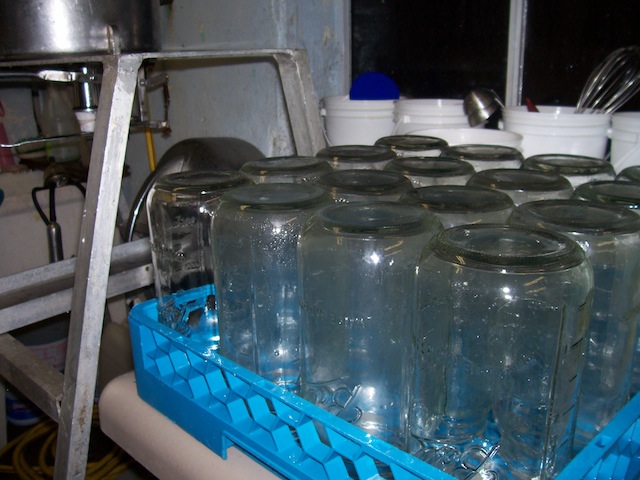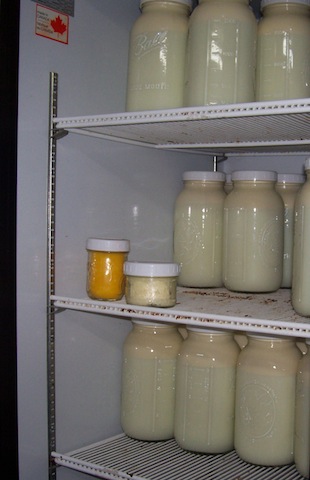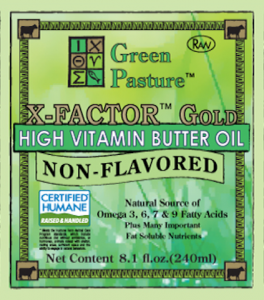
If you have only one cow, milking by hand makes the most sense. A generation ago my father used to milk sixteen cows by hand everyday. Most modern farmers would use a portable milking machine. Big processors have a milking parlor which is a massive capital investment.
I was listening to CBC Radio today and heard a warning from the BC Center for Disease Control about raw milk contamination at Home On The Range in Chilliwack, BC. I have not been able to find a reference to any sickness caused by the contamination. Please read Raw Milk Products Contaminated for the full story. This is my response to the CBC News article:

These are glass jars just washed and sterilized in a commercial dishwasher. The device to the left is used to filter and pour the milk into the jars.
My name is Caroline Cooper. I am the Chapter Leader for the Weston A Price Foundation in Kamloops, BC. The Weston A Price Foundation supports people trying to get nourishing traditional foods. Raw milk is one of these traditional foods that has nourished generations of farming families.
The cooperative members of Home on the Range want to have a product that they cannot get through the Industrial Food System. These members have pooled their resources to buy a herd of milking cows. They have contracted with an agister/milker and lease land so the members can get raw milk.
I would hope in a free country like Canada, a group of like minded individuals would still have the right to organize themselves and, as a group, contract for special services or products. If safety is a true concern, this closed system of commerce is very safe.
I believe the needs of the BC Center for Disease Control and the cooperative members of Home on the Range are not that far apart. Everyone wants a safe product. It would be more helpful if the BC Center for Disease Control used its excellent resources to help the cooperative to improve their safety protocols. I would hope an enlightened government would use its power to help, not penalize, its citizens.
It is important to realize that it might be great if the government used its resources to help herdshare programs improve their safety methods, but the government does not have jurisdiction regarding inspection or regulation of the products of the herdshare program. This is because the products of the herdshare are not being sold. The monetary transaction occurs between the herdshare members and the agister/milker under contractual agreement. Any products of the herd are shared between the herdshare members in proportion to the member’s shareholding. (If there are any lawyers out there that can weigh in on this point of law, I would appreciate it.)

Here is raw milk, raw butter and raw butter oil stored in the fridge after processing. Do citizens have the right to make a contract with a farmer for special foods? Should the government have the right to impose their rules into the voluntary transactions of citizens?
Updated January 6, 2010: This is a link to Michael Schmidt’s blog called The Bovine. There is a posting written by Gordon Watson, a herdshare member of Home on the Range, about the situation in Chilliwack, BC. This is a link to Health Authority Cracks Down On Raw Milk. It is a story about Deb Purcell’s search for better health for her child.
I still have not been able to find any proof that someone has become sick from the stated food contamination. If anyone sees any test results from the BC Center for Disease Control please forward the information to me.
Undated January 7, 2010: I contacted Sally Fallon yesterday and she had a number of questions that the BC Center for Disease Control could answer to clarify this situation:
1. How many people in the area became sick?
2. How many of these people drank raw milk?
3. Did they test the milk?
4. If so, did they find a pathogen?
5. If they found a pathogen, did it match the pathogen that made people sick?
Many of the answers are in the following email from Home on the Range. The email was written by Gordon Watson, a long term member of the Home on the Range cooperative:
On January 6, 2010, I got a copy of the lab results which was given to one of our former depots, by Vancouver Coastal Health. A ‘cfu’ means colony forming unit. The presence of colonies of bacteria is the way foods, in particular milk, are tested for pathogens. It is important to realize that we live in a world of bacteria everywhere. Colonies of bacteria may be either ‘good’ bacteria or ‘bad’ for human beings. For purposes of food safety, what matters is the sheer quantity of colonies present in a one gram sample of milk. The less the better. The FOOD QUALITY SAMPLING RESULTS for milk from our herd show that the colony forming units range between 1,300 for the butter and up to 3,000 for other products. The fluid milk was 2,400. Thus, the tests from the BC Center for Disease Control show that our milk is well under the 10,000 cfu standard for pasteurized homogenized milk retailed in BC.
I still cannot find a reference to anyone becoming sick. Therefore a tie to the strain of bacteria found in the raw milk products is irrelevant at this point.
January 14, 2010: I have just received an email from a shareholder/worker of Home on the Range. Sui Ryu has started a blog about her insider experience with the raw milk issue in Chilliwack, BC. This issue is not only about having access to a nourishing traditional food such as raw milk. It is about the individual’s basic right to choose the source and type of food the individual considers healthy.
Updated January 21, 2010: Michael Schmidt, Raw Milk Activist, Acquitted!





